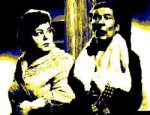Film Review

Perfectly cast as the forceful yet pitifully vulnerable Sabine is Béatrice Romand, one of Eric Rohmer's favourite actresses. Romand had previously featured in Rohmer's Le Genou de Claire (1970) (playing the manipulative teenager Laura) and would appear in several of the director's subsequent films, most notably Conte d'automne (1998). Sabine's victim, Edmond, is skilfully portrayed by André Dussollier, whose body language in his scenes with Romand is so expressive that his dialogue is pretty well superfluous. Dussollier had previously had a substantial part in Rohmer's Perceval le Gallois (1978), the film which marked the screen debut of Arielle Dombasle, here cast as the Jane Austen-like matchmaker Clarisse. Rohmer was so taken with Dombasle that he subsequently gave her a leading role in Pauline à la plage (1983), which is widely considered one of his best films.
Romand's Sabine and Dombasle's Clarisse make a striking contrast, and it is through this contrast that Sabine's folly is exposed to great effect. For Sabine, Clarisse represents the acme of womanhood, happily married to a wealthy man and able to indulge her artistic interests, freed from the burden of having to earn her own wage to supplement the household income. Of course, Clarisse's apparent freedom is illusory and she sees her marriage for what it truly is, an unnecessary stricture imposed on her by society, or rather the bourgeois stratum of society to which she so evidently belongs. Sabine does not see the limitations of Clarisse's existence, she sees only the perceived benefits of being a kept woman. Her ideas of marriage are as muddled and absurdly childish as her views on feminism, so the learning curve she subjects herself to as she goes after her idea of connubial bliss will inevitably be a steep and painful one. But, as we see from the film's ending, the experience was well worthwhile. Wasn't it Jane Fonda (that well-known one-woman feminist movement and patron saint of Lycra) who popularised the phrase: there's no gain without pain?
© James Travers 2002
The above content is owned by frenchfilms.org and must not be copied.
Film Synopsis
Sabine is a 25 year old student in art history at Paris University. She is currently having an affair with a married man, Simon, but she suddenly decides to put an end to the relationship when she grows tired of the incessant phone calls from her lover's wife and children. Declaring her intention to find a husband of her own, she heads back to her home town of Le Mans. At a wedding reception, Sabine's best friend Clarisse introduces her to a successful young lawyer named Edmond. In an instant, Sabine decides that Edmond is the man she will marry, but he disappears before she has an opportunity to get her hooks into him. Convinced that Edmond will make the ideal husband, Sabine begins a relentless campaign of seduction, ringing his office repeatedly and luring him back to Le Mans on the smallest pretext. What she has not allowed for is the possibility that Edmond may have no intention of getting married...© James Travers
The above content is owned by frenchfilms.org and must not be copied.
Similar Films
Here are some other films you may enjoy watching:- La Clé sur la porte (1978)
- A Handful of Dust (1988)
- Trop belle pour toi (1989)
- Franz (1971)
- Métisse (1993)
Other related links:
Film Credits
- Director: Eric Rohmer
- Script: Eric Rohmer
- Cinematographer: Bernard Lutic
- Music: Ronan Girre, Simon des Innocents
- Cast: Béatrice Romand (Sabine), André Dussollier (Edmond), Féodor Atkine (Simon), Arielle Dombasle (Clarisse), Huguette Faget (Maryse, Antique Dealer), Thamila Mezbah (Mother of Sabine), Sophie Renoir (Lise), Hervé Duhamel (Frédéric), Pascal Greggory (Nicolas), Virginie Thévenet (The Bride), Denise Bailly (Comtesse), Vincent Gauthier (Claude), Anne Mercier (La secrétaire), Catherine Rethi (Cliente), Patrick Lambert (Voyageur)
- Country: France
- Language: French
- Support: Color
- Runtime: 97 min
- Aka: A Good Marriage
The best French war films ever made

The Carry On films, from the heyday of British film comedy

The greatest French film directors
